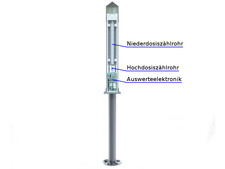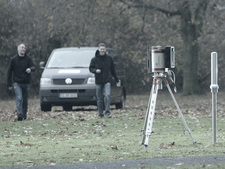-
Topics
Subnavigation
Topics
How measurements work
- Interpretation of measurements
- ODL probe: Design / Maintenance
-
ODL-INFO
Subnavigation
ODL probe: Design / Maintenance
- Stationary and quasi-stationary ODL probes consist of two Geiger-Müller counters. The counters are filled with gas and build an electric field. If particles penetrate the tube wall, a voltage pulse is generated. The counters register this pulse.
- BfS staff visits each ODL measuring station for an inspection at least every four years to ensure regular maintenance of the measuring network.
The ODL measuring network consists of stationary probes using connections for power supply and for the transmission of data. Nowadays, most of the stations work by mobile radio communication, some work by local area network. Additionally, if needed, there is the possibility to use stations with independent power supply.
In addition, "quasi-stationary" probes are also available. These are mobile probes with an independent power supply. In the event of an incident, the measuring network can be reinforced by using these probes within a potentially affected area. This makes it possible to assess the radiological situation more accurately on a local level and to obtain a more precise overview of the situation.
Design and function of the probes

![]() Design of an ODL probe: low-dose counter, high-dose counter and electronic analysis system
Design of an ODL probe: low-dose counter, high-dose counter and electronic analysis system
The stationary and quasi-stationary ODL probes are largely identical in design. They consist of two Geiger-Müller counters. The counters are filled with gas and build an electric field. If particles penetrate the tube wall, a voltage pulse is generated. The counters register this pulse.
The gas-filled counter tubes are different in size so that they cover an extremely large measuring range, reaching from 0.04 microsievert per hour to 5 sievert per hour.
The low-dose counter
The highly sensitive "low-dose counter" makes it possible to determine the base level of the ambient dose rate. This is the level of the natural environmental radioactivity, which is typically between 0.04 and 0.25 microsievert per hour in Germany or in Europe.
The high-dose counter
To cater for all scenarios, the second counter – the "high-dose counter" – makes it possible to determine an ambient dose rate of up to 5 sievert per hour. The data generated by the ODL probes is analysed to obtain a total value for the ambient radiation. However, this value does not show the different types of radionuclides involved.
Spectrometering ODL probes
Spectrometering ODL probes are used to register gamma radiation and x-rays depending on their amount of energy.
A scintillator detector, for example, transforms the energy contained in the radiation into light pulses. It reinforces the light and creates an analogue electric signal from this light. The electric signal is transformed into a digital value that can be analysed by the system. If these signals are recorded over a longer period of time – such as 30 minutes – they yield a spectrum. This spectrum can be used to deduce the type of radionuclides involved and their intensity.

![]() BfS staff performs maintenance work on an ODL probe
BfS staff performs maintenance work on an ODL probe
Maintenance
BfS staff visits each ODL measuring station for an inspection at least every four years to ensure regular maintenance of the measuring network.
At this occasion the BfS staff performs the pending service tasks and carries out a function test as well as an electrical equipment check.
These tasks serve for quality assurance of the measuring station.
Site selection
When selecting the location of a stationary ODL probe, various factors must be taken into account:
- Location of the probe in the ODL monitoring network:
The monitoring network has a grid of approximately 20 x 20 kilometers throughout Germany, and the locations of the ODL monitoring sites are based on this. - Surroundings:
Ideally, there should be a flat meadow within a radius of 30 meters around the probe, since tall vegetation (trees) or buildings influence the measured values. Therefore, if possible, a forest should not be directly adjacent to the ODL measuring station. In mountainous regions, usually only a valley location comes into question. - Infrastructure and legal framework for land use:
An ODL measuring station requires electricity and a mobile or fixed network connection. The permission to use the site and the necessary infrastructure (power connection) is contractually regulated in a "Gestattungsvereinbarung" (permit agreement). The majority of ODL probes in the BfS monitoring network are located on properties owned by the public sector (municipalities, counties, states, federal government). - Safety requirements:
At the location of the ODL measuring point, the requirements of electrical safety and lightning protection must be met.
State of 2024.03.14

